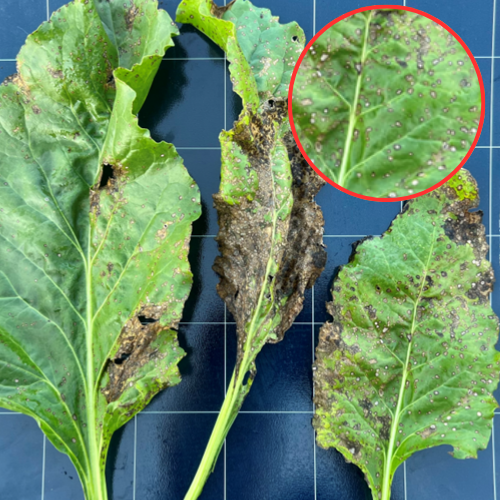February 23, 2024 - Cercospora leaf spot, caused by the fungus Cercospora beticola, is one of the most economically significant diseases affecting sugarbeet production in the US. This destructive disease can lead to severe defoliation, reduced sugar content, and ultimately diminished yields if left unmanaged. In this article, we'll delve into the characteristics of Cercospora leaf spot, its impact on sugarbeet crops, and effective strategies for its prevention and control.
Cercospora leaf spot typically appears as small, circular lesions on sugarbeet leaves, initially starting as yellowish spots that gradually enlarge and turn brown or purplish-black as the disease progresses. These lesions may coalesce, leading to extensive leaf damage and premature defoliation. Cercospora beticola produces airborne spores that spread through splashing water, wind, and farm equipment, facilitating the rapid dissemination of the disease within and between sugarbeet fields.
There are many detrimental effects of Cercospora leaf spot on sugarbeet crops. Severe leaf defoliation resulting from extensive lesion development compromises the photosynthetic capacity of the plants, leading to reduced sugar accumulation in the roots. Additionally, premature leaf drop diminishes canopy cover, exposing sugarbeet roots to direct sunlight and increasing the risk of sunburn and reduced sugar yield. Moreover, infected leaves left in the field can serve as a source of inoculum for subsequent disease cycles, perpetuating the problem in future growing seasons.
Management Strategies:
- Resistant Varieties: Planting sugarbeet varieties with genetic resistance to Cercospora leaf spot is a crucial component of disease management. Breeding programs have developed resistant cultivars with improved tolerance to Cercospora leaf spot, offering growers an effective long-term solution for disease control.
- Crop Rotation: Implementing a sound crop rotation strategy can help reduce the buildup of Cercospora inoculum in the soil. Rotate sugarbeets with non-host crops such as cereals or legumes to break the disease cycle and minimize disease pressure in subsequent seasons.
- Fungicide Applications: Timely application of fungicides is essential for managing Cercospora leaf spot in sugarbeet fields. Fungicides can effectively control Cercospora leaf spot when applied preventatively or in response to disease onset. A newly released product from Vive Crop Protection, Phobos™ FC fungicide has been shown to have enhanced disease control of Cecospera leaf spot on sugarbeets when compared to Proline®.
- Cultural Practices: Adopt cultural practices that promote optimal plant health and vigor, such as balanced fertility management, proper irrigation scheduling, and weed control. Healthy plants are better equipped to withstand disease pressure and recover from Cercospora leaf spot infections.
Cercospora leaf spot poses a significant challenge to sugarbeet growers, requiring proactive management strategies to mitigate its impact on crop yield and quality. By implementing a combination of resistant varieties, crop rotation, fungicide applications, and cultural practices, growers can effectively manage Cercospora leaf spot and sustainably produce high-quality sugarbeet crops.
Always read and follow label directions. Quadris® is a registered trademark of Syngenta. Proline® is a registered trademark of Bayer Group. Allosperse®, AZterknot®, AZteroid®, Phobos™, and Precision Chemistry™ are trademarks of Vive Crop Protection Inc. ©2024 Vive Crop Protection Inc.

